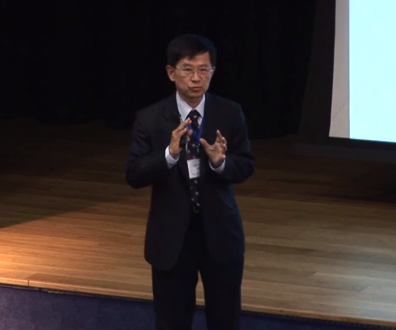Secondary hardened bainite: APMS conference
Duration: 32 mins 56 secs
Share this media item:
Embed this media item:
Embed this media item:
About this item

| Description: |
A lecture given by Jer Ren Yang, at the Adventures in the Physical Metallurgy of Steels (APMS) conference held in Cambridge University. The metallurgy of a new, microalloyed bainitic steel that is capable of secondary hardening, accompanied by a simultaneous increase in strength and ductility is introduced. The presentation file can be downloaded from http://www.msm.cam.ac.uk/apms/
http://www.msm.cam.ac.uk/phase-trans |
|---|
| Created: | 2013-10-27 15:53 |
|---|---|
| Collection: | Adventures in the Physical Metallurgy of Steels |
| Publisher: | University of Cambridge |
| Copyright: | Professor H.K.D.H. Bhadeshia |
| Language: | eng (English) |
| Keywords: | bainite; steel; metallurgy; secondary hardening; carbides; |
| Abstract: | Ideally, a low carbon bainitic microstructure offers an excellent combination of good toughness, strength and weldability. The typical microstructure of low-carbon bainitic steels is composed of a fine substructured bainitic ferrite matrix with certain amounts of uniformly distributed carbon-rich second phases. These second phases, located among the sheaves of bainitc ferrite, consist basically of martensite/austenite (M/A) constituents. As a result of the low-angle character of boundaries of bainitic ferrite sub-unit within the sheaf structure, little or no evidence of ferrite boundaries could be detected by an optical microscope. It is worth further improving appreciation of the transformation and to evaluate the effect of substructure characteristics on the properties. The main purpose of this work was to investigate the effect of Mo addition on the development of microstructure in the hot-rolled low-carbon Nb-containing bainitic steels. The steel strips were fabricated by the combined processes of controlled-rolling and accelerated-cooling. Microstructural characterisation and mechanical testing for the corresponding strips have been investigated. The results show that the Mo addition has the advantage of producing a high volume fraction of bainite, which possesses a significant secondary hardening after tempering treatment. It is suggested that the secondary hardening effect provides an additional way to increase the strength of Nb-Mo-containing bainitic steels. |
|---|---|
Available Formats
| Format | Quality | Bitrate | Size | |||
|---|---|---|---|---|---|---|
| MPEG-4 Video | 1280x720 | 2.95 Mbits/sec | 728.90 MB | View | Download | |
| MPEG-4 Video | 640x360 | 1.88 Mbits/sec | 466.80 MB | View | Download | |
| WebM | 1280x720 | 2.98 Mbits/sec | 737.67 MB | View | Download | |
| WebM | 640x360 | 805.52 kbits/sec | 194.40 MB | View | Download | |
| iPod Video | 480x270 | 491.15 kbits/sec | 118.47 MB | View | Download | |
| MP3 | 44100 Hz | 249.83 kbits/sec | 60.32 MB | Listen | Download | |
| Auto * | (Allows browser to choose a format it supports) | |||||

